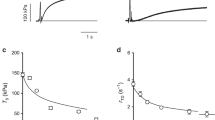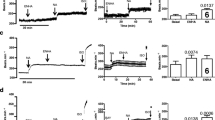Summary
The influence of several phosphodiesterase-blocking agents on some mechanical and metabolic parameters of isolated perfused guinea pig hearts was studied in order to reinvestigate the repeatedly demonstrated close correlation between these functions.
-
1.
In concentrations which caused 50% inhibition of the phosphodiesterase, theophyllin (1.8×10−4M), ethacrynic acid (4×10−4M) and papaverine (1×10−5M) produced positive inotropic effects by increasing the rate of contraction of the heart muscle (dp/dt). The other substances tested, furosemide (5×10−4M) and hydrochlorothiazide (1.5×10−3M), did not significantly influence the mechanical function of the hearts (Fig.1, upper chart).
-
2.
The coronary flow was increased by all these drugs, especially by furosemide and hydrochlorothiazide (Fig. 1, lower chart).
-
3.
Rather uniform metabolic effects were always observed: The oxygen consumption was increased (most prominently by substances with positive inotropic actions) (Fig.2), the glycogen content was reduced (Fig.3, upper chart), and the lactate efflux from the hearts was raised (Fig.3, lower chart). The lactate content (Fig.3, middle chart) and the lactate-pyruvate-ratio were increased only under the influence of hydrochlorothiazide and ethacrynic acid.
-
4.
Moreover, the myocardial content of phosphorylase-a was significantly increased by all these pharmacological agents (Fig. 4). The control activity was 15.3±0.25% of the total phosphorylase activity and this value was augmented to 23–26% (theophylline, papaverine, furosemide, hydrochlorothiazide) or even to 38% (ethacrynic acid).
The results do not support the concept of a common regulation of the mechanical and metabolic function of the heart muscle based solely on the cyclic-AMP-phosphorylase system. The difficulties in correlating the metabolic changes described with the simultaneous changes in contractile force and coronary flow of the heart muscle are discussed.
Similar content being viewed by others
Literatur
Belford, J., Feinleib, M. R.: Phosphorylase activity of heart muscle under various conditions affecting force of contraction. J. Pharmacol. exp. Ther.127, 257–264 (1959).
—, Feinleib, M. R.: The increase in glucose-6-phosphate content of the heart after the administration of inotropic catecholamines, calcium and aminophylline. Biochem. Pharmacol.11, 987–994 (1962).
Butcher, B. W., Sutherland, E. W.: Adenosine 3′,5′-phosphate in biological materials. J. biol. Chem.237, 1244–1250 (1962).
—, Ho, R. J., Meng, H. C., Sutherland, E. W.: Adenosine 3′,5′-monophosphate in biological materials: II. Measurement of cyclic 3′,5′-AMP in tissues and the role of the cyclic nucleotide in the lipolytic response of fat to epinephrine. J. biol. Chem.240, 4515–4523 (1965).
Cheung, W. Y., Williamson, J. R.: Kinetics of cyclic adenosine monophosphate changes in rat heart following epinephrine administration. Nature (Lond.)207, 979–981 (1965).
Cori, G. T., Illingworth, B.: The effect of epinephrine and other glycogenolytic agents on the phosphorylase a content of muscle. Biochim. biophys. Acta (Amst.)21, 105–110 (1956).
Dhalla, N. S., Mc Lain, P. L.: Effect of cardio-active drugs on the rate, contractile force and phosphorylase activity in frog heart. Arch. int. Pharmacodyn.163, 272–283 (1966).
— —: Studies on the relationship between phosphorylase activation and increase in cardiac function. J. Pharmacol. exp. Ther.155, 389–396 (1967).
Drummond, G. J., Duncan, L., Hertzman, E.: Effect of epinepkrine on phosphorylase-b-kinase in perfused rat hearts. J. biol. Chem.241, 5899–5903 (1966).
—, Valadares, J. R. E., Duncan, L.: Effect of epinephrine on contractile tension and phosphorylase activation in rat and dog hearts. Proc. Soc. exp. Biol. (N.Y.)117, 307–309 (1964).
— — —: Cardiac phosphorylase and phosphorylase kinase, pp. 111–124. In: Muscle, Proc. Symp. Univ. of Alberta, Edit. W. M. Paul, E. E. Daniel, O. M. Kay and G. Monckton. Oxford: Pergamon Press 1965.
Friesen, A. J. D., Allen, G., Valadares, J. R. E.: Calcium induced activation of phosphorylase in rat hearts. Science155, 1108 (1967).
—, Oliver, N., Allen, G.: Activation of cardiac glycogen phosphorylase by calcium Amer. J. Physiol.217, 445–450 (1969).
Haugaard, N., Hess, M. E.: Actions of autonomic drugs on phosphorylase activity and function. Pharmacol. Kev.17, 27–69 (1965).
Hess, M. E., Haugaard, N.: The effect of epinephrine and aminophylline on the phosphorylase activity of perfused contracting heart muscle. J. Pharmacol. exp. Ther.122, 169–175 (1958).
—, Hottenstein, D., Shanfeld, J., Haugaard, N.: Metabolic effects of theophylline in cardiac and skeletal muscle. J. Pharmacol. exp. Ther.141, 274–279 (1963).
Klainer, L. M., Chi, Y. M., Freidberg, S. L., Rall, T. W., Sutherland, E. W.: Adenyl cyclase: IV. Effects of neurohormones on the formation of adenosine 3′,5′-phosphate by preparations from brain and other tissues. J. biol. Chem.237, 1239 to 1243 (1962).
Klaus, W., Krebs, R.: Über die Abhängigkeit der Strophanthineinwirkung auf den myokardialen Sauerstoffverbrauch vom Funktionszustand des Herzens. Naunyn-Schmiedebergs Arch. Pharmak.264, 337–353 (1969).
Krebs, E. G., Fischer, E. H.: The role of metals in the activation of muscle phosphorylase. Ann. N.Y. Acad. Sci.88, 378–384 (1960).
—, Graves, D. J., Fischer, E. H.: Factors affecting the activity of muscle phosphorylase-b-kinase. J. biol. Chem.234, 2867–2873 (1959).
Kukovetz, W. R., Hess, M. E., Shanfeld, J., Haugaard, N.: The action of sympathomimetic amines on isometric contraction and phosphorylase activity of the isolated rat heart. J. Pharmacol. exp. Ther.127, 122–127 (1959).
—, Juan, H., Pöch, G.: Zum Wirkungsmechanismus der Papaverinwirkung auf isolierte Coronargefäße. Naunyn-Sehmiedebergs Arch. Pharmak.264, 262–263 (1969).
—, Pöch, G.: Zur Frage des Angriffspunktes der Herzwirkung von Methylxanthmen. Naunyn-Schmiedebergs Arch. exp. Path. Pharmak.243, 343–345 (1962).
— —: Relationship between metabolic and mechanic adrenergic stimulation of the heart under conditions of small dosage, low calcium, hypothermie, and ouabain. Biochem. Pharmacol.16, 1429–1438 (1967).
Mayer, S. E., Cotten, De V. M., Moran, N. C.: Dissociation of the augmentation of cardiac contractile force from the activation of myocardial phosphorylase by catecholamines. J. Pharmacol. exp. Ther.139, 275–282 (1963).
—, Moran, N. C.: Relation between pharmacologic augmentation of cardiac contractile force and the activation of myocardial glycogen phosphorylase. J. Pharmacol. exp. Ther.129, 271–281 (1960).
—, Williams, B. J., Smith, J. M.: Adrenergic mechanisms in cardiac glycogen metabolism. Ann. N.Y. Acad. Sci.139, 686–702 (1967).
Mc Neill, J. H., Nassar, M., Brody, T. M.: The effect of theophylline on amineinduced cardiac phosphorylase activation and cardiac contractility. J. Pharmacol. exp. Ther.165, 234–241 (1969).
Mommaerts, W. F. H. M., Seraydarian, K., Uchida, K.: On the relaxing substance of muscle. Biochem. biophys. Res. Commun.13, 58–60 (1963).
Morgan, H. E., Parmeggiani, A.: Regulation of glycogenolysis in muscle. II. Control of glycogen phosphorylase in isolated perfused heart. J. biol. Chem.239, 2435 to 2440 (1964).
Murad, F., Sutherland, E. W., Rall, T. W., Chi, Y. M.: The effect of catecholamines and choline esters on the formation of adenosine 3′,5′-phosphate by preparations from cardiac muscle and liver. J. biol. Chem.237, 1233–1238 (1962).
Nakatani, G.: The effect of adrenaline on the phosphorylase activity of the heart in the open-chest rat. Jap. J. Pharmacol.13, 282–291 (1963).
Namm, D. H., Mayer, S. E.: Effects of epinephrine on cardiac cyclic 3′,5′-AMP, phosphorylase kinase and phosphorylase. Molec. Pharmacol.4, 61–69 (1968).
Nayler, W. G.: Calcium exchange in cardiac muscle: a basic mechanism of drug action. Amer. Heart J.73, 379–394 (1967).
—, Wright, J. E.: Effect of epinephrine on the mechanical and phosphorylase activity of normo and hypothermic hearts. Circulat. Res.13, 199–206 (1963).
Neely, J. R., Liebermeister, H., Morgan, H. E.: Effect of pressure development on membrane transport of glucose in isolated rat heart. Amer. J. Physiol.212, 815–822 (1967).
Øye, J.: The action of adrenaline in cardiac muscle. Dissociation between phosphorylase activation and inotropic response. Acta physiol. scand.65, 251–258 (1965).
Ozawa, E., Ebashi, S.: Requirement of Ca-Ion for the stimulatory effect of cyclic 3′,5′-AMP on muscle phosphorylase-b-kinase. J. Biochem. (Tokyo)62, 285–286 (1967).
Pöch, G., Juan, H., Kukovetz, W. R.: Einfluß von herz und gefäßwirksamen Substanzen auf die Aktivität der Phosphodiesterase. Naunyn-Schmiedebergs Arch. Pharmak.264, 293–294 (1969).
Posner, J. B., Stern, R., Krebs, E. G.: Effects of electrical stimulation and epinephrine on muscle phosphorylase, phosphorylase-b-kinase and adenosine 3′,5′-phosphate. J. biol. Chem.240, 982–985 (1965).
Price, J. M., Nayler, W. G.: Effect of hypothermia on the response of isolated rat myocardium to xanthine derivatives. Arch. int. Pharmacodyn.166, 390–397 (1967).
Rall, T. W., West, T. C.: The potentiation of cardiac inotropic responses to norepinephrine by theophylline. J. Pharmacol. exp. Ther.139, 269–274 (1963).
Rasmussen, H., Tenenhouse, A.: Cyclic adenosine monophosphate, Ca++, and membranes. Proc. nat. Acad. Sci. (Wash.)59, 1364–1370 (1968).
Robison, G. A., Butcher, R. W.: The effect of epinephrine on 3′,5′-AMP levels in the isolated perfused rat heart. Molec. Pharmacol.1, 168–177 (1965).
Santi, R., Contessa, A. R., Ferrari, M.: Spasmolytic effect of the papaverine and inhibition of the oxidative phosphorylation. Biochem. biophys. Res. Commun.11, 156–159 (1963).
Seifter, S., Dayton, S., Novie, B., Muntwyler, E.: The estimation of glycogen with the anthrone reagent. Arch. Biochem.25, 191 (1950).
Seitz, N., Klaus, W., Krebs, R.: Über die Wirkung von Phosphodiesterase-Hemmstoffen am Herzen. Naunyn-Schmiedebergs Arch. Pharmak.264, 307–308 (1969).
Senft, G.: Beeinflussung hormonaler und enzymatischer Regulationen des KH-Stoffweehsels bei Anwendung von Benzothiadiazinen. Internist7, 426–435 (1966).
Shanefeld, J., Frazer, A., Hess, M. E.: Dissoziation of the increased formation of cardiac 3′,5′-AMP from the positiv inotropic effect of norepinephrine. J. Pharmacol. exp. Ther.169, 315–320 (1969).
Sutherland, E. W.: The effect of the hyperglycemic factor of the pancreas and of epinephrine on glycogenolysis, pp. 441–463. In: Recent Progr. in Hormone Res., Proc. of the Laurentian Hormone Conf., Edit G. Pincus, Vol. 5. New York: Academic Press Inc. 1950.
—: The effect of the hyperglycemic factor and epinephrine on liver and muscle phosphorylase. In: Phosphorus Metabolism, vol. 1, pp. 53–56. Edit. W. D. McElroy and B. Glass. Baltimore: John Hopkins Press 1951.
—: Cori, C. F.: Effect of hyperglycemic-glycogenolytic factor and epinephrine on liver phosphorylase. J. biol. Chem.188, 531–543 (1951).
—, Robison, G. A.: The role of cyclic 3′,5′-AMP in responses to catecholamines and other hormones. Pharmacol. Rev.18, 145–161 (1966).
— —, Butcher, R. W.: Some aspects of the biological role of cyclic AMP. Circulation37, 279–306 (1968).
Williamson, J. R.: Metabolic effects of epinephrine in the isolated perfused rat heart. J. biol. Chem.239, 2721–2729 (1964).
—: Metabolic effects of epinephrine in the perfused rat heart. II. Control steps of glucose and glycogen metabolism. Molec. Pharmacol.2, 206–220 (1966).
—, Jamieson, D.: Dissociation of the inotropic from the glycogenolytic effect of epinephrine in the isolated rat heart. Nature (Lond.)206, 364–367 (1965).
Wollenberger, A., Ristan, O., Schoffa, G.: Eine einfache Technik der extremschnellen Abkühlung größerer Gewebestücke. Pflügers Arch. ges. Physiol.270, 399 bis 412 (1960).
Author information
Authors and Affiliations
Additional information
Über einige Ergebnisse wurde anläßlich der 10. Frühjahrstagung der Deutschen Pharmakologischen Gesellschaft in Mainz berichtet (Seitz et al., 1969).
Stipendiat der Deutschen Forschungsgemeinschaft.
Rights and permissions
About this article
Cite this article
Klaus, W., Krebs, R. & Seitz, N. Über die Dissoziation von Funktion und Stoffwechsel des isolierten Meerschweinchenherzens unter dem Einfluß von Phosphodiesterase-Hemmstoffen. Naunyn-Schmiedebergs Arch. Pharmak. 267, 99–113 (1970). https://doi.org/10.1007/BF00999393
Received:
Issue Date:
DOI: https://doi.org/10.1007/BF00999393




